|
Reims Cathedral
High Gothic, 1211-1290 |



|
Learning from the developments at Chartres, the architect(s) of Reims designed a vault only seven feet higher but nine feet narrower. Thus the nave seems even higher. Soaring verticality is the keynote of High Gothic architecture. |
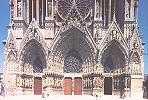

|
Like many High Gothic cathedrals, the Cathedral at Reims is dedicated to the Virgin Mary. Her coronation in Heaven is depicted prominently in the tracery above the main entrance. Note the lacy, pierced architecture in this scene as well as in the rose window behind it. As Gothic architecture develops, delicate tracery such as this becomes prominent.
|
|
Beauvais Cathedral
High Gothic, begun 1247 |

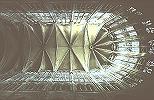
|
Not to be outdone by the architects of Chartres and Reims, the planners of the cathedral at Beauvais designed vaulting 157 feet high. (Chartres was a mere 120!) In 1284 the vaults of the nave, which had been on even slenderer supports than those at Chartres or Reims, collapsed. Today only the choir (the east end) is still standing, having been rebuilt with a greater margin of error. Still, it is an impressive example of the attempt to make architecture out of line and light, not mass and solid forms.
|
|
Ste. Chapelle, Paris 
High Gothic, 1243-1248
|


|
This small church (small, compared to the preceding Gothic cathedrals) adjoining the royal palace, was designed as a private chapel for King Louis IX (later canonizes as Saint Louis) especially to house the relics he brought back after the Sixth Crusade.
The exterior itself looks like a delicately sculpted reliquary.
|

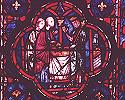

|
This royal chapel is justly famous for its stained glass. Here the wall is almost totally dissolved so that more than three-quarters of the "wall" is composed of glass. The windows themselves are about 49 feet high and 15 wide. What is left of the wall is highly decorated with statues, strips of mosaic, and delicate tracery.
Some of the stained glass windows depict the arrival and celebration of the relics of Christ's Passion that King Louis IX had obtained.
|
|
Milan Cathedral
Late Gothic, begun 1386
|
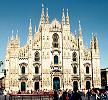
MAS
|
The Gothic style spread throughout western Europe, often with variations unique to the locality. The cathedral in Milan, Italy, indicates the fusion of French and classical traits. (In northern Italy, Milan was more influenced by French art than other Italian cities.) Italian Gothic churches are typically more wide than tall. Even so, the decoration and details are French. Notable exceptions are the classical pediments above the windows and doors of the facade.
|
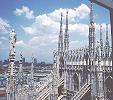

both MAS
|
High above the ground, the buttresses are intricately carved. While cathedrals like these were built for the glory of God -- who could see these buttresses -- it is also true that churches such as these demonstrated civic pride. Given the expense of building these huge structure, they indicate as well the wealth of the cities which built them and a late medieval economy which could sustain such a display of beauty and grandeur. |
